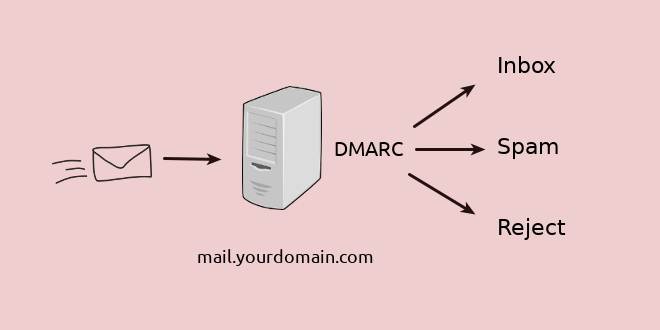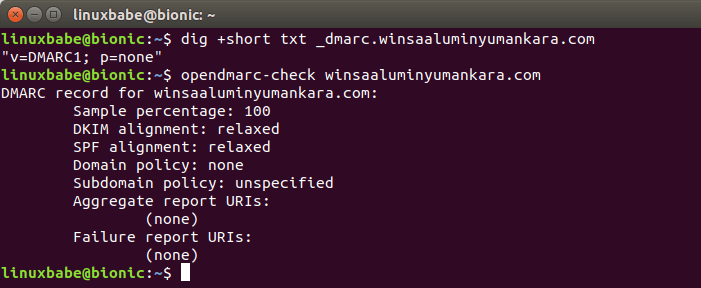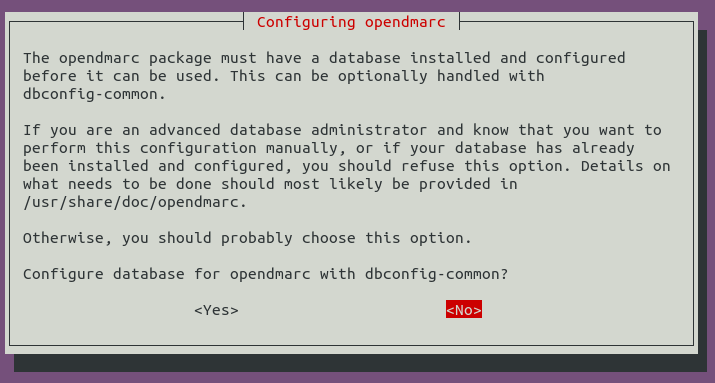Set Up OpenDMARC with Postfix on Debian to Block Spam/Email Spoofing
In previous articles, we discussed several effective tips to block email spam. This tutorial will be showing you how to set up OpenDMARC with Postfix SMTP server on Debian to block email spoofing and spam. OpenDMARC is an open-source DMARC email policy filter for MTAs (Message Transport Agent, aka SMTP server).
What is DMARC
DMARC (Domain-based Message Authentication, Reporting, and Conformance) is an Internet standard (RFC 7489) that allows domain owners to prevent their domain names from being used by email spoofers. Before DMARC is invented, it is very easy for bad actors to use other people’s domain names in the sender From: address.
If a domain owner created DMARC DNS record for his/her domain name and a receiving email server implemented DMARC check, then bad actors need to pass SPF alignment or DKIM alignment in order to pass DMARC check. If DMARC check fails, the spoofed email could be rejected, never to be seen by end-users. It’s difficult for the bad actor to pass SPF or DKIM, unless the domain owner’s email server is compromised.

Email Spoofing Example
A spammer sent me a ransom email using winsaaluminyumankara.com in the From address. The whois information of winsaaluminyumankara.com is public. Clearly the spammer is not a person responsible for this domain name.

winsaaluminyumankara.com has a DMARC record.

Then I checked the email headers, which shows SPF failed. There’s no DKIM signature. So DMARC check fails. This is a spoofed email.

This goes to show that not only big brands are being used by email spoofers, any domain names on the Internet could be impersonated by bad actors. Unfortunately the DMARC policy for this domain name is p=none, which tells receiving email server to do nothing special if DMARC check fails. If the policy is to p=reject, then my Postfix SMTP server would reject this email with OpenDMARC.
Paypal and Facebook have created a reject DMARC policy for their domain name.

So if a bad actor tries to spoof Paypal or Facebook, my email server can reject the spoofed email with OpenDMARC. There are many other well-known domain names that deployed a reject DMARC policy, as can be seen in the table below.
|
|
|
|
|
|
|
|
|
|
|
|
|
|
|
|
The secure mailbox provider Protonmail is using Postfix and OpenDMARC to perform DMARC checks on inbound emails and I will show you how to do the same on your own Postfix SMTP server.
Prerequisites
This tutorial is for mailbox providers and anyone who run their own mail server, to protect their users from being scammed by email spoofing. If you are a domain name owner and want to prevent your domain name from being used by email spoofers, please read this article to create DMARC record and analyze DMARC report. I also recommend you to read that article if you don’t fully understand DMARC.
To follow this tutorial, you need to get SPF and DKIM verification working first, because DMARC depends on the SPF and DKIM verification results to make a final decision.
Setting up OpenDMARC with Postfix SMTP Server on Debian
OpenDMARC is open-source software that can perform DMARC verification and reporting. It’s already in the Debian repository, so you can run the following command to install it.
sudo apt install opendmarc
If you are asked to configure a database for OpenDMARC with dbconfig-common, you can safely choose No.

Once installed, it will be automatically started. Check its status with:
systemctl status opendmarc
Output:
● opendmarc.service - OpenDMARC Milter Loaded: loaded (/lib/systemd/system/opendmarc.service; disabled; vendor preset: enabled) Active: active (running) since Tue 2018-10-30 19:49:52 CST; 23s ago Docs: man:opendmarc(8) man:opendmarc.conf(5) Main PID: 14858 (opendmarc) Tasks: 6 (limit: 1110) CGroup: /system.slice/opendmarc.service └─14858 /usr/sbin/opendmarc
Hint: If the above command doesn’t quit immediately, you can make it quit by pressing the Q key.
Note that auto-start at system boot time is disabled. We can enable it by:
sudo systemctl enable opendmarc
Then edit the main configuration file with your text editor.
sudo nano /etc/opendmarc.conf
Find the following line:
# AuthservID name
By default, OpenDMARC uses the MTA hostname as the AuthserveID, but it’s better to use a different name for the authentication service, because Amavisd-new will overwrite the authentication results header added by OpenDMARC. You can change it to the following, which will be very easy for you to see which program adds which authentication-results header.
AuthservID OpenDMARC
Next, add the following line. Replace the hostname with your real Postfix hostname. This tells OpenDMARC to trust authentication result with mail.yourdomain.com in the ID. This is needed when you have OpenDKIM running to do DKIM verification.
TrustedAuthservIDs mail.yourdomain.com
If the Postfix hostname isn’t included in the TrustedAuthservIDs, or you have a typo in the hostname, then OpenDMARC will ignore the Authentication-Results header generated by OpenDKIM, and you will find the following error message in the mail log /var/log/mail.log
opendmarc[1133]: A436A205C9 ignoring Authentication-Results at 1 from mail.yourdomain.com
Then find this line:
# RejectFailures false
By default, OpenDMARC won’t reject emails that fail DMARC check, even if the domain’s policy is set to p=reject. If you prefer to reject emails that fail DMARC check when the domain’s policy is set to p=reject, then uncomment this line and change false to true.
RejectFailures true
You may want OpenDMARC to ignore SMTP clients that are successfully authenticated via SMTP AUTH. For example, I have a Postfix SMTP server running on my blog web server that uses my main mail server as a relay to send notification emails, so I want openDMARC to ignore emails that are submitted from my blog web server. This also applies to desktop/mobile mail clients that submit outgoing emails over port 587. In this case, add the following line at the end of this file.
IgnoreAuthenticatedClients true
Add the following line at the end of this file.
RequiredHeaders true
This will reject emails that don’t conform to email header standards as described in RFC5322. For example, if an incoming email doesn’t have From: header or date: header, it will be rejected. A From: field from which no domain name could be extracted will also be rejected.
It’s recommended to also add the following line at the end of this file. This will make OpenDMARC perform a fallback SPF check itself when it can find no SPF results in the message header.
SPFSelfValidate true
OpenDMARC is implemented as a milter (mail filter). Postfix can talk to milter applications via Unix socket. The default socket file used by OpenDMARC is /var/run/opendmarc/opendmarc.sock. But the Postfix SMTP daemon shipped with Debian runs in chroot jail, which means the SMTP daemon resolves all filenames relative to the Postfix queue directory (/var/spool/postfix). So we need to change the socket file used by OpenDMARC.
Find the following line.
Socket local:/var/run/opendmarc/opendmarc.sock
Change it to:
Socket local:/var/spool/postfix/opendmarc/opendmarc.sock
Save and close the file. On Debian 16.04, there’s no Socket defined in this file, you just need to add the above line in the file.
/etc/default/opendmarc file can also set the socket file location, but the opendmarc package on Debian 18.04 and 20.04 doesn’t read this file, so we need to set the socket file path in /etc/opendmarc.conf file.Create a directory to hold the OpenDMARC socket file and change the ownership so that opendmarc user and opendmarc group can access it.
sudo mkdir -p /var/spool/postfix/opendmarc sudo chown opendmarc:opendmarc /var/spool/postfix/opendmarc -R
Change permission to 750 to restrict access, so users not in group opendmarc can’t access this directory.
sudo chmod 750 /var/spool/postfix/opendmarc/ -R
Add user postfix to group opendmarc.
sudo adduser postfix opendmarc
Then restart OpenDMARC.
sudo systemctl restart opendmarc
Configure Postfix SMTP Server
Edit the main configuration file.
sudo nano /etc/postfix/main.cf
If you have already configured OpenDKIM, then you should have lines in this file like below.
# Milter configuration milter_default_action = accept milter_protocol = 6 smtpd_milters = local:opendkim/opendkim.sock non_smtpd_milters = $smtpd_milters
Now you just need to add the OpenDMARC socket file so that Postfix can talk to OpenDMARC. (Make sure it’s after the OpenDKIM socket.)
# Milter configuration
milter_default_action = accept
milter_protocol = 6
smtpd_milters = local:opendkim/opendkim.sock,local:opendmarc/opendmarc.sock
non_smtpd_milters = $smtpd_milters
Save and close the file. Then restart Postfix for the change to take effect.
sudo systemctl restart postfix
If you use iRedMail
If you used iRedMail to set up your mail server, then you don’t have OpenDKIM. iRedMail uses Amavis to do DKIM signing and verification, but OpenDMARC can’t read the DKIM verification results from Amavis, which will result in DMARC check failure. So, we need to set up DKIM verification as follows.
Run the following command to install OpenDKIM.
sudo apt install opendkim
Edit OpenDKIM main configuration file.
sudo nano /etc/opendkim.conf
Find the following line
#Mode sv
By default, OpenDKIM will act as both a signer (s) and a verifier (v). Since iRedMail already uses Amavis to do DKIM signing, we just need OpenDKIM to act as a verifier, so OpenDMARC can read the verification result. Remove the # symbol and change the mode to verifier.
Mode v
Then add the following lines at the end of this file.
#OpenDKIM user # Remember to add user postfix to group opendkim UserID opendkim # Hosts to ignore when verifying signatures ExternalIgnoreList /etc/opendkim/trusted.hosts InternalHosts /etc/opendkim/trusted.hosts Socket local:/var/spool/postfix/opendkim/opendkim.sock
Save and close the file. Add postfix user to opendkim group.
sudo adduser postfix opendkim
Create the trusted hosts file.
sudo mkdir /etc/opendkim/ sudo nano /etc/opendkim/trusted.hosts
Add the following lines to the newly created file.
127.0.0.1
localhost
*.your-domain.com
The above means that messages coming from the above IP addresses and domains will be trusted. Save and close the file. Then change ownership.
sudo chown -R opendkim:opendkim /etc/opendkim
Next, create a directory to hold the OpenDKIM socket file and only allow opendkim user and group to access it.
sudo mkdir /var/spool/postfix/opendkim sudo chown opendkim:opendkim /var/spool/postfix/opendkim
If you can find the following line in /etc/default/opendkim file.
SOCKET="local:/var/run/opendkim/opendkim.sock"
Change it to
SOCKET="local:/var/spool/postfix/opendkim/opendkim.sock"
After that, we need to edit Postfix main configuration file.
sudo nano /etc/postfix/main.cf
Add the following lines at the end of this file to connect Postfix with OpenDKIM and OpenDMARC.
# Milter configuration milter_default_action = accept milter_protocol = 6 smtpd_milters = local:opendkim/opendkim.sock,local:opendmarc/opendmarc.sock non_smtpd_milters = $smtpd_milters
Save and close the file. Restart OpenDKIM, OpenDMARC and Postfix.
sudo systemctl restart opendkim opendmarc postfix
Testing OpenDMARC Verification
Now send an email from your other email address like Gmail to your domain address. After that, check the email headers. If OpenDMARC is working correctly, you can see the DMARC verification results like below.
Authentication-Results: OpenDMARC; dmarc=pass (p=none dis=none) header.from=gmail.com
I sent an email from my Gmail account to my domain email address and it passed DMARC verification. If you don’t see this email header, then check your mail logs.
sudo nano /var/log/mail.log
You will see something like below, which means OpenDMARC is working.
opendmarc[26495]: implicit authentication service: mail.linuxbabe.com opendmarc[26495]: 61DAA3EA44: gmail.com pass
If you see the following message.
ignoring Authentication-Results at 1 from mail.linuxbabe.com
it means OpenDMARC is ignoring the SPF and DKIM verification results, so OpenDMARC isn’t working. You need to add the following line in /etc/opendmarc.conf file, then restart OpenDMARC.
TrustedAuthservIDs mail.yourdomain.com
If you change the Postfix myhostname parameter, remember to add the new hostname to TrustedAuthservIDs. You can add multiple hostnames, separated by comma.
TrustedAuthservIDs mail.yourdomain.com,mail2.yourdomain.com
Testing OpenDMARC with Telnet
You can use telnet to spoof another domain name, such as paypal.com. First, run the following command on your local computer to connect to port 25 of your mail server.
telnet mail.yourdomain.com 25
Then use the following steps to send a spoof email. (You type in the bold texts.)
HELO mail.paypal.com 250 mail.yourdomain.com MAIL FROM:<[email protected]> 250 2.1.0 Ok RCPT TO:<[email protected]> 250 2.1.5 Ok DATA 354 End data with <CR><LF>.<CR><LF> From: [email protected] To: [email protected] Subject: Please update your password. Click this link to update your password. . 550 5.7.1 rejected by DMARC policy for paypal.com quit
As you can see, my mail server rejected this email because it didn’t pass DMARC check and Paypal deployed a p=reject policy.
Note: If a domain’s DMARC policy is set to p=quarantine, then OpenDMARC milter will put the spoofed email into the Postifx hold queue indefinitely. The postmaster can list all messages in the queue with postqueue -p command and use the postsuper command line utility to release messages in the hold queue.
How to Whitelist an IP Address in OpenDMARC
If you want to allow your other server to relay emails via port 25 of your main mail server which runs OpenDMARC, then you should whitelist the IP address of the other server in OpenDMARC, because OpenDMARC will check the From: domain in relay emails as well.
Edit OpenDMARC config file.
sudo nano /etc/opendmarc.conf
Add the following line at the end of this file.
IgnoreHosts /etc/opendmarc/ignore.hosts
Save and close the file. Then create the /etc/opendmarc/ directory.
sudo mkdir /etc/opendmarc/
Create the ignore.hosts file.
sudo nano /etc/opendmarc/ignore.hosts
Add the IP addresses you want to whitelist in this file like so:
127.0.0.1 12.34.56.78
Save and close the file. Then restart OpenDMARC.
sudo systemctl restart opendmarc
Conclusion
I hope this tutorial helped you set up OpenDMARC with Postfix SMTP server on Debian to block email spoofing and spam. As always, if you found this post useful, then subscribe to our free newsletter to get more tips and tricks. Take care 🙂



FINALLY!!!!!!!!
I can block those annoying email imposters with OpenDMARC.
Thanks for the great tutorial.